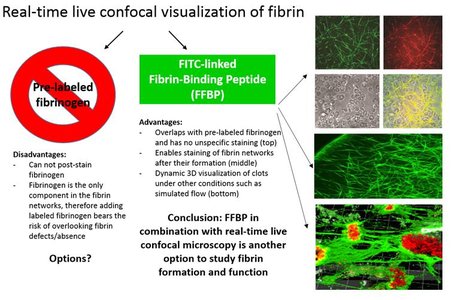-
Home
-
About JCTR
-
Gold Open Access
-
Issues
-
Editorial board
-
Author guidelines
-
Publication fees
-
Online first
-
Special issues
-
News
-
Publication ethics
-
Partners
-
Submit your manuscript
-
Submit your review report
-
Editorial Office
-

This work is licensed under a Creative Commons Attribution-NonCommercial 4.0 International License. ISSN print: 2382-6533 ISSN online: 2424-810X
Volume 3 Issue 2
FITC-linked Fibrin-Binding Peptide and real-time live confocal microscopy as a novel tool to visualize fibrin(ogen) in coagulation
Nikolaj Weiss, Bettina Schenk, Mirjam Bachler, Cristina Solomon, Dietmar Fries, Martin Hermann
Weiss et al., J Clin Transl Res, 2017(3): 3
Published online: May 24, 2017
Abstract
Background and Aim: Although fibrinogen has been established as a key player in the process of coagulation, many questions about the role of fibrinogen under specific conditions remain. Confocal microscopic assessment of clot formation, and in particular the role that fibrinogen plays in this process, is commonly investigated using pre-labeled fibrinogen. This has a number of drawbacks, primarily that it is impossible to stain fibrin networks after their formation. To present an alternative for conveniently post-staining fibrin in a wide range of models/situations, in real time and with high resolution.
Methods: We combined a peptide known to bind fibrin and linked it to fluorescein isothiocyanate (FITC), creating the FITC-Fibrin-Binding Peptide (FFBP). We subsequently tested its fibrin-binding capability in vitro under static conditions, as well as under simulated flow, using real-time live confocal microscopy.
Results: Fibrin stained with FFBP overlaps with fibrin stained with fibrinogen pre-labeled with Alexa Fluor 647 following coagulation induction. In contrast to pre-labeled fibrinogen, FFBP also stains already formed fibrin networks. By combining FFBP with real-time live confocal microscopy even the visualization of single fibrin fibers is possible.
Conclusions: These data indicate that FFBP is a valid and valuable tool for real-time live confocal assessment of clot formation. Our findings present a valuable alternative for the visualization of fibrin even after its formation, and we believe this approach will be particularly valuable for future investigations of important, but previously overlooked, aspects of clot formation.

DOI: http://dx.doi.org/10.18053/jctres.03.201702.003
Author affiliation
1 Department of Anesthesiology and Critical Care Medicine, Medical University Innsbruck, Innsbruck, Austria
2 Institute for Sports Medicine, Alpine Medicine and Health Tourism, UMIT - University for Health Sciences, Medical Informatics and Technology, Hall, Austria.
3 Department of Anesthesiology, Perioperative Medicine and General Intensive Care, Paracelsus Medical University, Salzburg, Austria
4 Ludwig Boltzmann Institute for Experimental and Clinical Traumatology and AUVA Research Centre, Vienna, Austria
*Corresponding author
Martin Hermann
Department of Anesthesiology and Critical Care Medicine, Innsbruck Medical University, Innrain 66, 6020 Innsbruck, Austria
Tel: +43 512 504 27795
Fax: +43 512 504 27793
E-mail: Martin.Hermann@i-med.ac.at
Handling editor:
Michal Heger
Department of Experimental Surgery, Academic Medical Center, University of Amsterdam, the Netherlands
Downloads
Supplemental figure 1 (2.9 MB)
Supplemental video 2 (997.8 KB)

